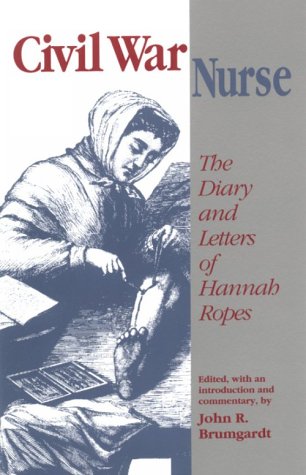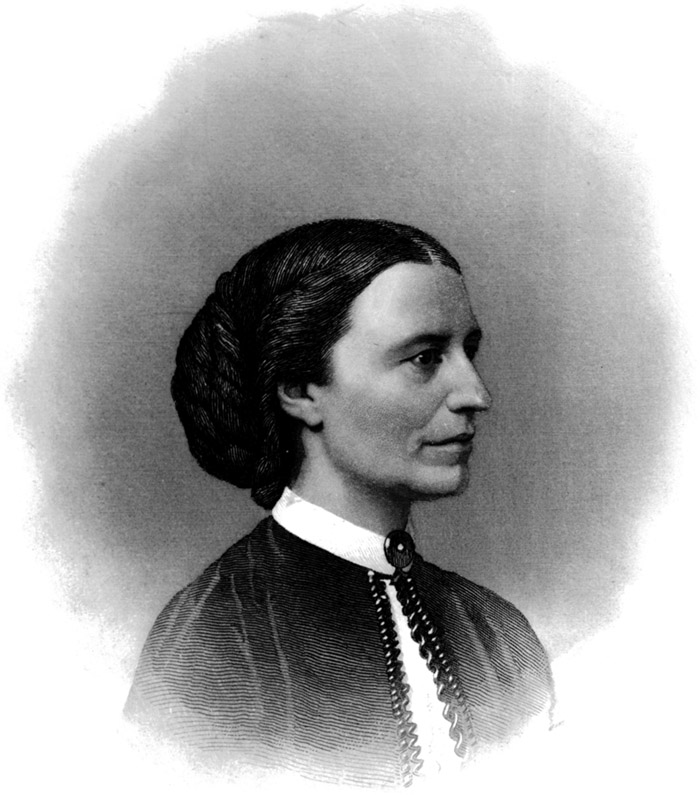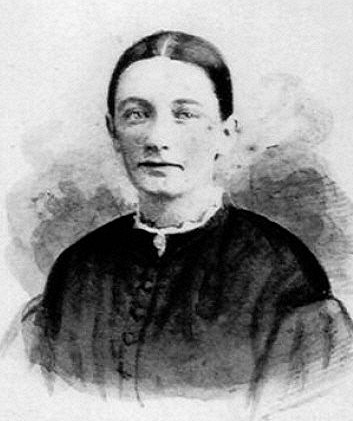The American Civil War produced many outstanding figures. One of those was the nurse Hannah Anderson Ropes. Ropes had an intriguing life before the Civil War, and fought to improve the conditions of soldiers during the war. Joshua V. Chanin explains.
I currently work at Texas A&M University-Commerce, where the university is expecting to christen a state-of-the-art nursing facility in the fall. I have known several nursing students during my undergraduate and graduate studies, who have told me that their major is one of the toughest offered at the university due to the lab classes after school hours and the numerous reports they have to write—I agree (sometimes they look like they do not decently sleep). To celebrate the tough, rewarding, and sometimes overlooked work of nurses, I have decided to write about Hannah Anderson Ropes, a nurse during the Civil War who was dedicated to improving her craft.
Early Life
Hannah Anderson Chandler was born on June 13, 1809, in New Gloucester, Maine. As her parents were prominent state lawyers, young Hannah was privately educated and raised in a wealthy household that championed Christianity. Hannah’s religious faith grew stronger as she aged, coinciding with her developing opposition to slavery. Although she was more vocal than many other women—a displeasure to the patriarchy—Hannah attracted the attention of William Ropes, an educator who believed the sexes were equal. The couple married in January 1834 and had four children, two of whom lived to adulthood.
The marriage was fruitful until in 1847, citing health concerns, William abruptly moved to warmer temperatures of Florida, leaving his wife and children behind. Abandoned by her spouse, Ropes moved to the Kansas Territory with her children. Ropes, along with her daughter, played a major role in spurring support for the 1856 abolitionist movement in the region, cooperating with male abolitionist leaders in local meetings. As she became more involved in the growing fight against slavery, Ropes strengthened the close bond she had with her children. Amidst the violence of ‘Bleeding Kansas,’—where pro-slavery raiders from Missouri were a threat to anti-slavery families—Ropes always went the extra mile to protect her children as she kept “loaded pistols and a bowie knife upon my table at night, [and] three sharp’s rifles, loaded, standing in the room.” Ropes did not let the disappearance of her husband upset her. Hannah Ropes became a liberal-feminist, a woman who vocally championed for the elimination of slavery while dutifully (and passionately) attending the household needs.
An Interest in Nursing
Hannah Ropes—who described the Kansas fighting as “the most unmitigated calamity Heaven ever suffered upon the earth”—moved back to Massachusetts in 1857, where she knew her family would be safe. It was in New England when Ropes became an author. Her unique writing talent led to the publication of her first book, Six Months in Kansas: By a Lady, which compiled a collection of letters Ropes wrote to her ailing mother while she lived in the mid-west. Ropes would later write a popular paperback of prairie life, Cranston House: A Novel, in 1859. Still active in political movements, Ropes desired an opportunity to help people. Her interest in nursing stemmed from reading literature by English nurse, Florence Nightingale. After Ropes’s nephew gave her a copy of Nightingale’s 1859 book, Notes on Nursing, which depicted the English’s nurse’s account of the Crimean War, Ropes’s career trajectory changed, foreshadowing the professional role the New England woman would play in the next stage of her life.
A New Position at the Union Hotel Hospital
At the start of the Civil War in spring 1861, the Union Hotel in Washington D.C.—which had been built in 1796 and hosted many prominent citizens including Robert Fulton and George Washington—was seized by the government and converted into a Union Army hospital. After Edward enlisted as a private in May 1862, Ropes quickly offered her services to the Office of United States Army Nurses, and was subsequentially placed at the former capital tavern. During this era, the nursing occupation was linked with a negative stigma—woman nurses were associated with prostitutes or ‘fallen women.’ However, as blood was shed as a result of several major Confederate victories, nurses became heroes of the Union Army. ‘Women of good conduct’ were speedily recruited to care for the sick and wounded. Ropes rose through the ranks because of job dedication, and in the autumn she was named the head matron of the Union Hotel Hospital. Her job responsibilities included training the hospital’s nurses and monitoring the general operations of the institution.
Upon taking the managerial post, she actively criticized the appalling conditions of the building and the former management—the complaints included lack of sanitation in the wards, the building’s decay, an absence of necessary supplies, and the cruel treatment of soldiers. Ropes strongly believed that every man in uniform (of every rank) deserved healthy surroundings, good food, and humanitarian treatment. This belief is evident by a diary entry she wrote in the first week of her new appointment in October 1862: “The poor privates are my special children of the present…the loss they have experienced in health, in spirits, in weakened faith in man, as well as shattered hope in themselves.” Rather than ignoring the problems at hand—as elected officials did at first—Ropes swiftly picked up the mantle, restructured the hospital’s management style, and brought real change to the depleted building. The head matron selected women who were eager to enter the nursing field, and trained them to treat all their patients with compassion. Moreover, the nurses were taught to ignore long hours of work (often without decent pay) because the soldiers were first priority and a nurse could not leave the building until their patients were comfortable. Discipline among the staff was introduced by the new management, as Ropes was not afraid to terminate nurses if they failed to address the needs of the wounded soldiers.
Strong Leadership
Head Matron Ropes quickly found out that most of the male staff at the D.C. hospital, including the surgeons, wanted to only help those who would survive—some argued that they did not have enough supplies for all the wounded soldiers. Ropes took disagreement with this belief as she wanted to save all the soldiers—she cited the laziness of men. Thus, she personally took extensive actions against staff who were cruel to the patients. On one occasion, Ropes had a surgeon arrested for graft (selling food and clothing meant for the hospital patients for profit). On November 1, 1862, the matron engaged in a heated argument with head surgeon Dr. Ottman regarding the man’s decision to lock a disease-infested soldier in a dark cellar to keep ‘a plague’ from spreading to the other wards. Dr. Ottman has plans to exterminate the wounded soldier. Ropes wanted to give the soldier time to recover; however her orders were stiffly ignored. As she did not let men trump her decisions, Ropes took her complaint to the office of the Secretary of War. Edward Stanton sided with the head matron and addressed the following note to the department’s provost marshal: “Go to the Union Hospital with this lady, take the boy out of that black hole, go into it yourself so as to be able to tell me all about it, then arrest the surgeon and take him to a cell in the old capital prison, to await further orders!” Subsequentially, Stanton wrote an order forbidding anyone from removing the head matron from her post. As she pressed on with her progressive nursing agenda, breaking down gender barriers, Hannah Ropes constructed an identity that emulated masculine traits—she was professional and dutiful in the toughest times. Although military generals often resented the sight of strongly opinionated women in hospitals, Ropes constantly butted heads with male colleagues, and held her ground with the best interests of the wounded soldiers at heart.
Comfort Among Chaos
In her position, Ropes worked longer hours than her colleagues—writing reports, ordering supplies, tirelessly advocating for hospital infrastructure improvements, and keeping a daily activity log. It was not uncommon to see Ropes tending to soldiers in the late hours of the night, only then to see her again at the hospital at the crack of dawn. Moreover, the head matron took an interest in writing letters to elected officials, politely asking them to either send extra blankets and supplies to the hospital or coaxing them to try and advocate politicians to pass funding stipends for the hospital. Ropes was in contact with a powerful figure in Congress. Massachusetts Senator Charles Sumner—the elected official who is famous for being nearly caned to death by South Carolinian politician Andrew Butler in 1856—was an established supporter of Ropes’s hospital reforms, and continuously tried to push parts of the head matron’s agenda on to the Senate floor.
Hannah Ropes’ passion for nursing and devotion in monitoring the wounded (day and night) are evident from several diary entries written by nurse Louisa May Alcott, who joined the staff at the hospital on December 13, 1862, shortly after her 30thbirthday. At this time, the Union Army was heavily engaged in the Battle of Fredericksburg, which resulted in over 10,000 wounded soldiers. The hospital’s staff was overwhelmed during the five days of conflict as nurses dispensed food and medication, changed smeared dressings, bathed patients, wrote letters to loved ones for soldiers, and held the hands of those who were dying. Although chaos occurred in the wards and bloody carnage littered the hospital’s floors, the steady hand Ropes provided her staff and the patients brought some assurance to those who were stressed. “All was hurry and confusion; the hall was full of these wrecks of humanity, for the most exhausted could not reach a bed till dully ticketed and registered; the walls were lined with rows of such as could sit, the floor covered with the more disabled, the steps and doorways filled with helpers and lookers on…and in the midst of it all, the matron’s motherly face brought more comfort to many a poor soul, than the cordial draughts she administered, or the cheery words that welcomed all, making of the hospital a home.” Alcott also recalls a time when she suggested the idea of drastically rationing the wounded’s meals after food was in short supply—Ropes, a selfless patriot, thought otherwise: “When I suggested the probability of a famine hereafter, to the matron, that motherly lady cried out: ‘Bless their hearts, why shouldn’t they eat? It’s their only amusement; so fill every one [bowl], and, if there’s not enough ready tonight, I’ll lend my share to the Lord by giving it to the boys.”
Sudden Illness and A Life Remembered
During the height of her nursing career, Hannah Ropes’ life abruptly came to an end in January 1863. On January 9, Ropes wrote a letter to her son Edward noting that she and Alcott “worked together over four dying men and saved all but one…we both too cold…and have pneumonia and have suffered terribly.” The women contracted the deadly virus known as typhoid pneumonia, a major killer of wounded soldiers during the Civil War. Although she was sick, Ropes continued to work (day and night) and put the lives of injured Union soldiers ahead of her own health. Alcott hovered between life and death, however, was able to recover in the spring. Ropes’s health continued to fade. On January 19, Ropes’s daughter, Alice sent a dismal update from the hospital to her brother: “Mother has been ill for some weeks and indeed all the nurses ill, so they sent for me to help a little.” The next day, January 20, 1863, Hannah Ropes took her last breath and died of the disease. She was fifty-three years old. Family and colleagues mourned. The Union Hotel Hospital was draped in black and a moment of silence took place among the wounded soldiers. Senator Sumner eulogized the matron’s life in a letter addressed to the family: “Mrs. Ropes was a remarkable character, noble and beautiful and I doubt if she has ever appeared more so than when she has been here in Washington, nursing soldiers.”
In an era where women were expected to master the roles of domesticity, keep their mouths closed, refrain from accepting educational or employment opportunities outside of the home, and sexually satisfy their spouses, Hannah Ropes convincedly (and tirelessly) blended the two spheres of a woman’s life together—nurturing and protecting her household while progressively crafting the nineteenth-century nursing field.
What do you think of Hannah Anderson Ropes’ life? Let us know below.
Finally, you can read about US Civil War nurses Clara Barton (here) and Cornelia Hancock (here).
References
Alcott, Louisa May. Hospital Sketches. New York: Applewood Books; Reissue edition, 1991.
Brumgardt, John R., ed. Civil War Nurse: The Diary and Letters of Hannah Ropes. Knoxville: University of Tennessee Press, 1993. First edition was written by Hannah Ropes.
Granstra, Pat. “Hannah Ropes: The Other Woman Behind ‘Little Women.’” Civil War Primer. Accessed January 18, 2019. http://www.civilwarprimer.com/2012/03/hannah-ropes-the-other-woman-behind-little-women/.
MacLean, Maggie. “Hannah Ropes: Head Matron at Union Hotel Hospital.” Civil War Women. Accessed January 19, 2019. https://www.civilwarwomenblog.com/hannah-ropes/.
New England Historical Society. “Hannah Ropes Spends Six Months in Kansas with Loaded Pistols and Bowie Knife.” Accessed January 18, 2019. http://www.newenglandhistoricalsociety.com/hannah-ropes-spends-6-months-in-kansas-with-loaded-pistols-and-bowie-knife/.
Nightingale, Florence. Notes On Nursing: What it is and What it is Not. London: Harrison, 1859.
Ropes, Hannah Anderson. Six Months in Kansas: By a Lady. Boston: J.P. Jewett, 1856.









